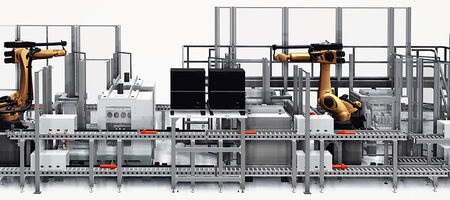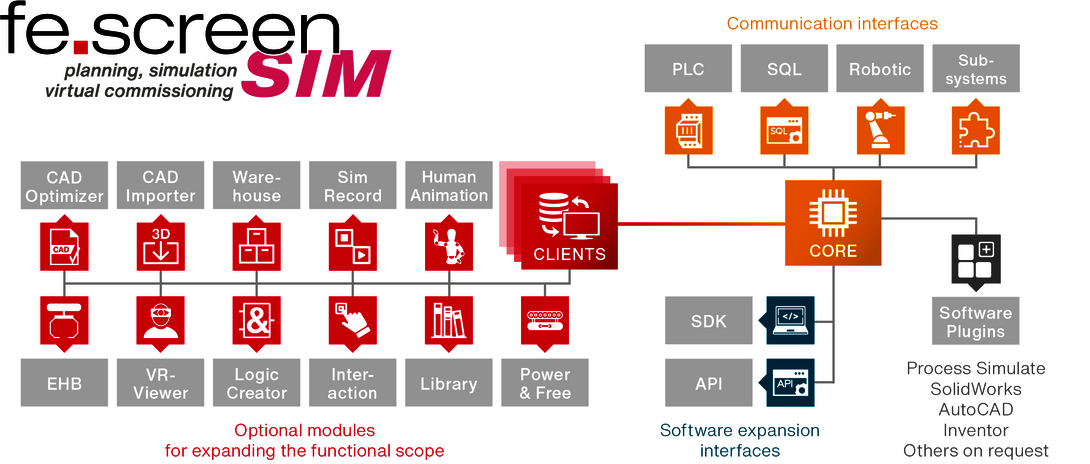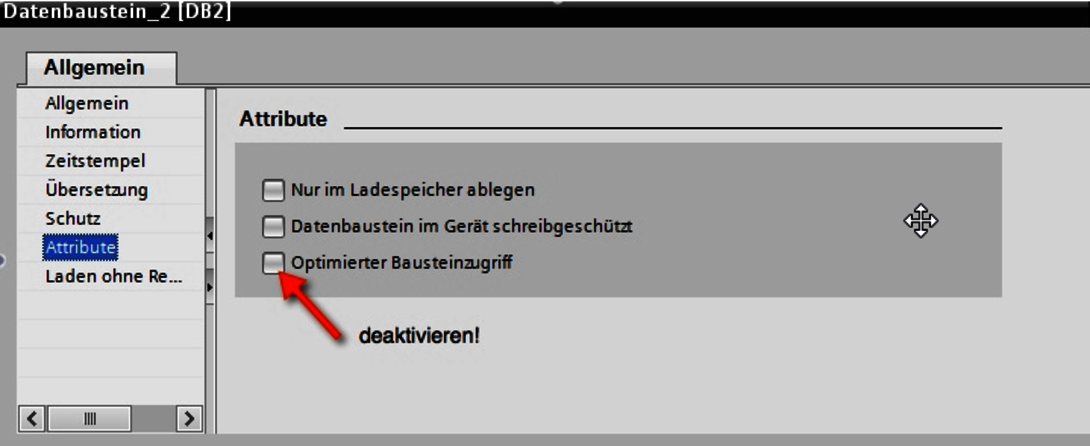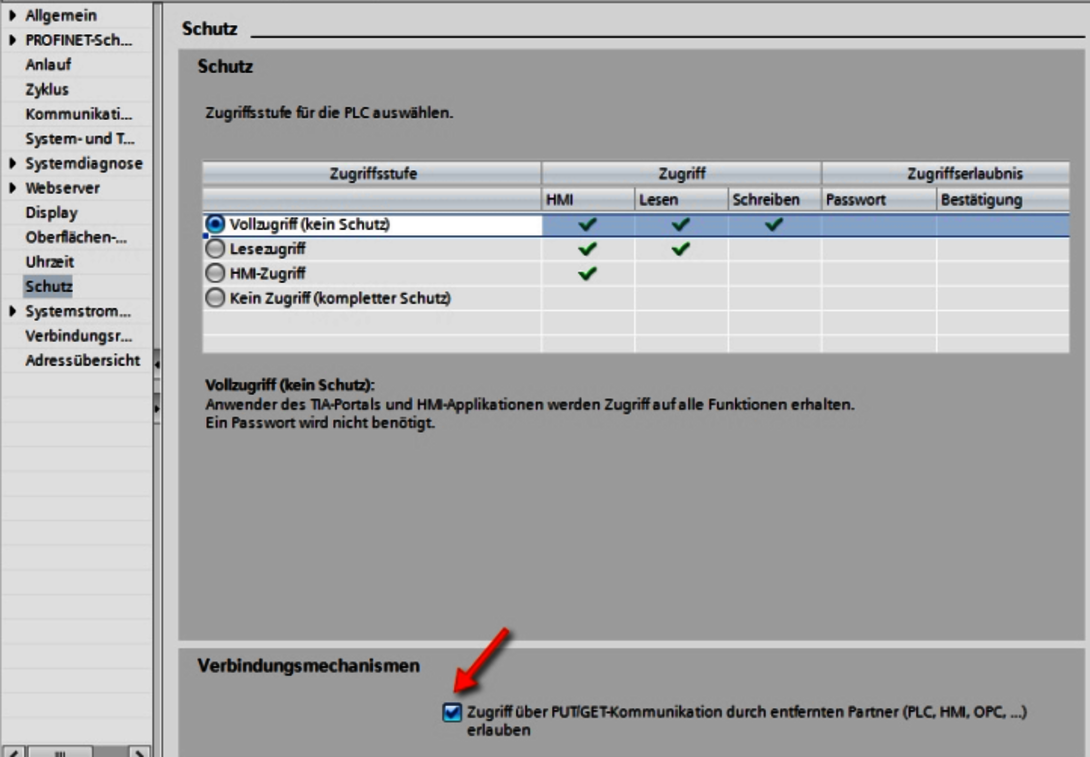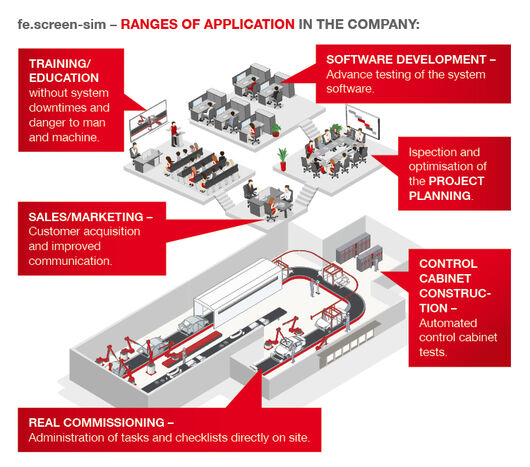Frequently Asked Questions
Questions on digital twins
When should a digital twin be used?
A digital twin should be used as early as possible in the engineering phase. Ideally, the simulation model is used as early as the planning phase, for example to check processes with regard to feasibility. During the process, the model is then enriched with more and more data. This diagram illustrates the time period.
How does a digital twin help me with a bidding process?
With more and more requests for proposals, the creation of a digital twin is required. Companies applying for the contract need a suitable solution. If no tool or a specific provider is specified, those responsible are faced with the task of selecting a suitable digital twin software. We would be happy to talk to you personally about your requirements and your time schedule.
In addition, a digital twin and the associated virtual commissioning offers further decisive advantages for tenders:
- Efficient planning: simulations allow you to identify potential problems at an early stage and optimise processes.
- Cost reduction: Virtual tests minimise errors before physical implementation, which contributes to an overall cost-efficient solution.
- Time savings: The technologies enable faster commissioning of systems - a decisive advantage, especially for time-critical projects.
- Better visualisation: Detailed digital twins offer customers realistic insights into your project, promote communication and impress with clear visualisations.
- Sustainability: The optimisation of processes contributes to a more sustainable implementation, which can be an additional advantage, especially in tenders with a focus on environmental aspects.
How quickly can a digital twin be created?
The time frame depends on several factors:
- System complexity: The more complex a system or the higher the level of detail, the longer it takes to create.
- Data quality: Good and available data speeds up the process.
- Availability of 3D models: Existing models from mechanical design can speed up the process.
- Simulation and modelling tools: Powerful tools and libraries such as behavioural models contribute to efficiency.
- Experience of the team: An experienced team can work faster.
- Goal and scope: The level of detail of the desired digital twin influences the time required.
The aim should be to create the model as automatically as possible. However, this is a process that needs to grow within the company.
After a personal conversation we will be happy to give you an initial cost estimate.
Will a digital twin help me in digital engineering
A digital twin is helpful for digital engineering in every respect. There are many reasons for this:
- Early validation makes it possible to identify design problems before physical prototyping.
- It promotes efficient collaboration by providing a central source of information for the teams.
- Simulation-based optimisation makes it possible to improve products and processes.
- Prototype reduction makes it possible to carry out many tests in the digital environment at an early stage.
- Systems can be monitored and controlled in real time.
- Life cycle management is also supported - from development to maintenance and optimisation.
- Data integrity and consistency can be ensured throughout the entire development process.
Overall, a digital twin optimises processes, improves product quality and strengthens the ability to innovate in digital engineering.
General questions / Technical questions
What does the license model of fe.screen-sim look like?
The fe.screen-sim licensing concept has a modular structure based on floating licenses.
The graphic shows an overview of the structure of the software.
Licensing details
- The heart of fe.screen-sim is the "CORE", in which a project can be loaded. Several CLIENTS can connect to the "CORE" and work on one project at the same time.
- Communication interfaces are also licensed at the "CORE". These can be, for example, interfaces to programmable logic controllers (PLCs), robot tools or subsystems.
- The required function modules are licensed directly to the individual CLIENTS and can be used flexibly on different computers via a license server.
- If required, the additional purchase of interfaces for individual software extensions and separate applications is possible.
Licensing example
A total of three employees are working on two different projects. In one project, Siemens is used as the PLC, in the other a control system from Allen Bradley. All three employees write function logics, e.g. in FUP or C#, and create operating elements. In one project, a connection to a Kuka robot is also implemented. It should be possible to import CAD data from every workstation, but not at the same time.
The following modules are required for this:
- 2 x Core module (because two projects are processed simultaneously)
- 1 x PLC module Siemens
- 1 x PLC module Allen Bradley
- 3 x client module (three employees access the two core modules)
- 3 x Logic creator (three employees work on logics in the projects simultaneously)
- 3 x Interaction module (three employees use switching elements, such as buttons for operation, etc. simultaneously)
- 1 x Robotic module Kuka
- 1 x CAD-Importer (After a CAD import the module can be restored on the license server).
Which data formats can be imported into fe.screen-sim?
The following data and file formats can be imported:
- CAD import: SolidWorks, Step, JT, OBJ, FBX u. v. m.
- SQL, XML and Excel.
Which external systems can be connected?
fe.screen-sim has interfaces to almost all common systems and data sources on the market.
- Controllers: Siemens S7 (series: 200, 300, 400, 1200, 1500) and compatible controllers (e. g. VIPA), Allen Bradley, Rockwell, Beckhoff (TwinCAT 3), Fanuc, WAGO, PLC-SIM Advanced, Simulation Unit.
- Robotics: KUKA, ABB, Fanuc (others on request).
- Subsystems: MATLAB®/Simulink®, WinMOD®, etc.
What are the system requirements for fe.screen-sim?
The ideal system configuration when using fe.screen-sim is as follows:
An overview of the ideal system requirements for ‘fe.screen-sim’ can be found in the data sheet.
Questions about virtual commissioning
What are the application areas and scenarios?
The use of fe.screen-sim is completely possible regardless of the industry. Currently, the software is already being used very successfully in plant and mechanical engineering, logistics, materials handling, automation and robotics.
Typical application scenarios are:
- Virtuelle Inbetriebnahme
- Process optimization
- Collision checks
- Functional tests
- Training scenarios
- Feasibility studies
- HMI operating concept tests
- Ergonomics considerations
In which business areas can the simulation be used?
Flexibility is a keyword that has always played a major role in the development of fe.screen-sim. Through a cross-departmental use of the 3D simulation software in the company, synergy effects can be used optimally and potential can be exploited in the best possible way.
On the one hand, simulation models can be created directly in fe.screen-sim without using an existing database. On the other hand, the import of data from CAD programs is possible, whereby many file formats (e.g. FBX, OBJ, WRL, JT, etc.) are supported.
In addition, programmable logic controllers (PLC) from a wide range of manufacturers (e.g. Allen Bradley, Rockwell, Schneider Electric, Siemens) can be integrated into fe.screen-sim.
Of course, the simulation of robots from various manufacturers - including ABB, Fanuc and KUKA - is also possible. An SQL database interface ensures the smooth integration of fe.screen-sim into the workflow.
What are the benefits of virtual reality in plant simulation?
The integration of an interface for different VR and AR glasses allows the user to immerse himself in the simulation. This makes it easier to estimate sizes and distances. New, impressive display possibilities open up. Take part in one of our next webinars! There you will learn more about it.
Who creates such a model in our company?
The field of virtual commissioning is new to engineering science. Therefore, many companies do not have trained personnel with specific responsibilities in this field. Ideally, the responsible employee should be a "virtual mechanic" who understands how the plant works and at the same time has a basic understanding of PLC. There are now so called simulation engineers who have specialised in virtual commissioning.
What is the best way to select software for a virtual commissioning solution?
We would be happy to organise a workshop with you and create an initial model based on your data. You will then receive a test installation and can test ‘fe.screen-sim’ extensively over several weeks.
A general recommendation for software selection would be:
- Clarify requirements: Define clear requirements and objectives for virtual commissioning (VIB) in order to identify the appropriate software.
- Check system compatibility: Ensure that the software is compatible with your existing systems and technologies.
- User-friendliness: Select software with an intuitive user interface to promote acceptance within the team.
- Check functionalities: Ensure that the software provides the functionality you need for your specific VIB requirements - e.g. simulation, 3D modelling, clash detection, etc.
- Scalability: Consider the scalability of the software to ensure it can grow with your organisation.
- Support and training: Check the availability of support and training options to ensure smooth deployment and training of your team.
- References and reviews: Read customer reviews, references and testimonials to assess the reliability and performance of software providers.
- Cost analysis: Consider not only the acquisition costs, but also ongoing licence fees, implementation costs and any training costs.
- Updates and future-proofing: Ensure that the software receives regular updates and is future-proofed to keep pace with changing requirements.
- Pilot phase: Start a pilot phase with the selected software to test its performance in real-life scenarios before finalising your decision.
Where is the market for virtual commissioning solutions heading?
The market for virtual commissioning solutions is undergoing dynamic change and is significantly influenced by various trends.
Sustainability as a key topic: A central focus is on sustainable technologies, as companies are looking for innovative solutions to fulfil environmental, social and management requirements. Virtual commissioning plays a role here by helping to reduce physical prototypes and thus save resources.
Integration of AI: A forward-looking trend is the increased integration of artificial intelligence (AI) into virtual commissioning solutions. AI enables advanced simulations, predictive analyses and automation, which further increases efficiency and enables innovative applications.
Metaverse as a development direction: The concept of the metaverse - a shared virtual 3D space - is becoming increasingly important. By 2027, over 40 per cent of major global companies are expected to use Web3, AR cloud and digital twins as part of metaverse projects. This development opens up new dimensions for virtual commissioning by creating immersive and collaborative working environments.
Cloud storage technology for flexibility: The increased use of cloud storage technology is helping to expand the market for virtual data rooms. This enables efficient storage and sharing of digital twins, further improving the scalability and flexibility of virtual commissioning solutions.
Overall, the market is moving towards an integrative, sustainable and technologically advanced orientation. The combination of virtual commissioning, AI, the emergence of the metaverse concept and cloud storage technology promises an exciting and forward-looking development in this area.
Your personal contact person – for more clearness
You are a project or department manager and are faced with the question of how to set up a digital twin for your project? We would be happy to talk to you personally about your requirements, the time frame, the possible project approach and give you an initial cost estimate.

